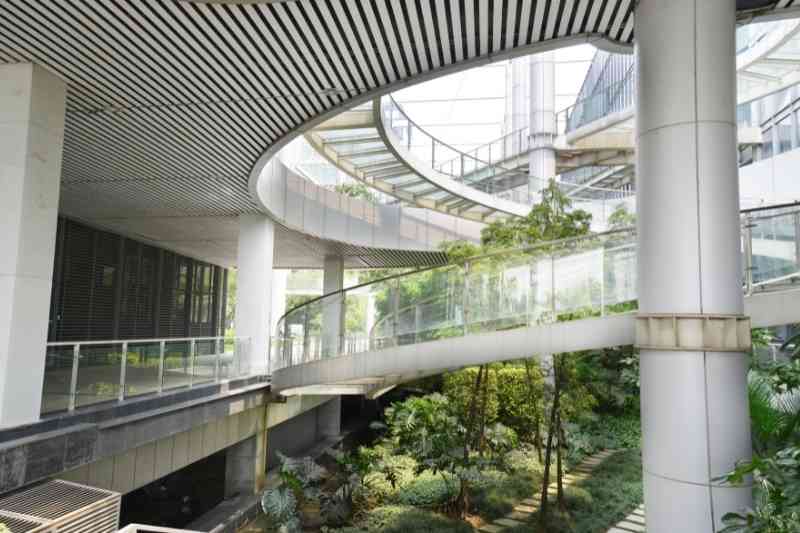
Our buildings have always been defined by their materials. Concrete — and then thousands of years later, steel — allowed for the construction of great cities and ever-taller buildings in the built environment. But what’s the next great innovation in construction material? For a growing school of architects and designers, it’s wood — but not just as scaffolding or framing. For these designers, the building block of the future is living wood.
Some designs use a metal superstructure that trees and other plants grow around. Other designers manipulate trees as they grow so that they form living structural supports. Whatever the case, building with living wood is one of architecture’s most exciting ideas. But it’s by no means a new one.
Read on to discover examples of organic architecture across history, understand its benefits, and learn how it will be more prominent in the future.
Navigate this post:
Discover the top 5 multifamily design trends:
History of organic architecture
You might have heard of elements of interior design, like tables or chairs, that have been grown straight out of the ground, molded into their intended shapes over a period of years with grafts and pruning. Throughout history, we’ve taken that same principle and applied it to architecture on a grander scale.
For example, consider the living root bridges that serve the residents of Meghalaya, India. In Meghalaya, the dampness and humidity would rot and degrade a traditional structure in no time. But all that humidity and rainfall are good for plant growth. So, the residents of Meghalaya learned to adapt to their environment and shape the way local trees grew.
As the trees’ roots thicken with age, the bridge can take more weight. While some of these living bridges are hundreds of years old, they’re not just a thing of the past. Current residents plan on accommodating increased levels of traffic by planting the roots and preparing double- or even triple-decker bridges, passing this sustainable method of building on to future generations.
Examples of living architecture abound worldwide. In France in the 16th century, a chapel was carved from an oak tree — people conduct pilgrimages to it to this day. More recently, though, organic architecture has exploded in popularity due to the Baubotanik school of thought. Baubotanik architects have built plant-based towers throughout Europe and continue to do so.

Benefits of organic architecture
While there’s still a lot of testing to go before we can plant the next skyscrapers, cities all over the world are reaping the benefits of plant-friendly architecture that puts greenery and people first. Emphasizing plants and biological elements is a school of thought called biophilic design.
More greenery in urban spaces is always a plus. Trees in urban spaces lower temperatures, clean the air, and have psychological benefits. They reduce stress and improve the moods of everybody in the surrounding neighborhood.
Organic architecture has great implications for future generations of developers and constructors, too. Today, the real estate industry accounts for 40% of all emissions on the planet! Creating steel and concrete, transporting materials to the build site, the actual act of construction — it all adds up and accelerates climate change.
But when you construct a building largely out of living wood, you won’t just stop contributing to those emissions. You’ll also actively be helping to slow the effects of climate change on the planet, because as trees mature they absorb CO2 from the air.
The benefits of biophilic design include lowered temperatures, increased sustainability, and better moods for residents. And buildings made of living wood take the positive effects of biophilic design and dial them up.

The future of organic architecture
As we step into the future, advances in commercial and multifamily architecture, biology, and botany will pave the way for organic architecture that’s easier to modify and construct.
Skyscrapers like the Oasia Hotel in Singapore have dozens of species of plants built directly into the building’s interior and exterior, and are winning awards for the way they fuse nature and innovation.
Even now, architectural firms are working on ways to ‘program’ tree growth right from its beginning, so that they can grow into predetermined shapes without being shaped by an outside force. It’s an idea that won first place in the eVolo Skyscraper Competition back in 2021.
As the idea of organic architecture becomes more mainstream, you can look forward to a greener, healthier, and more sustainable world. In the meantime, you can apply the principles of organic architecture in your day-to-day life.
Even if it’s something as simple as putting a potted plant on your windowsill, you should know that plants and greenery are more than accent pieces. Greenery is a way for you to connect with nature in an urban world — and, in the future, those plants may form the very foundations of the buildings you live in.






